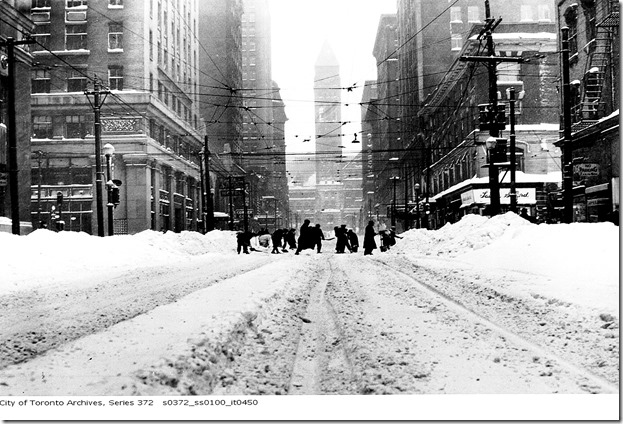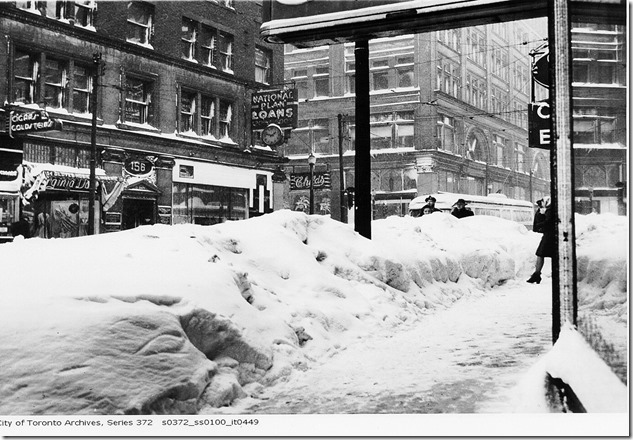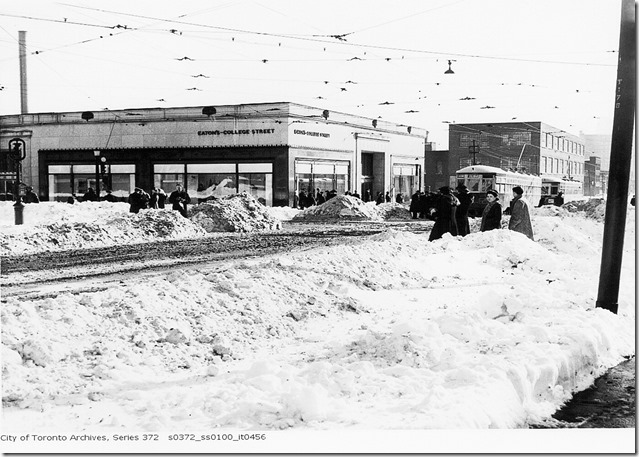Gazing north on Bay Street from Adelaide Street toward Queen Street and the Old City Hall, in December 1944.
In December 1944, the Second World War was raging across Europe and the Pacific, the casualty reports in the newspapers a dreaded part of daily life. However, in Toronto the economy was booming as many factories in Toronto had been converted to manufacture munitions, military uniforms and necessities for the soldiers overseas. The Ford plant in Oakville was turning out tanks, jeeps and trucks instead of automobiles.
Christmas was approaching and many foods were in short supply. In the days leading up to the yuletide event, my parents struggled to obtain treats for our festive dinner and for gifts to place under the tree. However, for my brother and me, anticipation of Santa’s all-important delivery conjured dreams of delight. We were young and not aware of the privations imposed by the war.
In 1944, anything that contained metal was scarce, since it was required for the war effort. Most toys were manufactured of wood—wooden cars, boats, building blocks, game boards and even the runners on sleds. Because food products became scarce, in 1942 the government rationed food and issued coupons to purchase many items. Even Jell-O was included as gelatine was used in manufacturing explosives. Other rationed foods were tinned products, as the metal to make tins was needed for other war purposes. My family longed for a few tins of salmon, but was rarely able to obtain them. Meat, butter, sugar, dairy products and flour also required coupons. The shortages were heightened because Canada was shipping vast supplies of food overseas to Britain to sustain the people on the home front, and to feed and clothe the soldiers across the English Channel. Silk was reserved for making parachutes, so women’s silk stockings were rare. Gasoline and rubber tires were also restricted, so people drove their cars less or not at all. However, the Christmas of 1944 was one of the most memorable of my life. It was not only because of family happiness, toys and food.
It was the year the greatest snowstorm on record ever to hit Toronto occurred. The snow began on a Monday evening, December 11th, when light flurries silently swirled across the streets and laneways.. Their intensity increased as midnight approached and in the early hours of the morning of December 12, Torontonians awoke to a wintry world beyond imagination. By 8:00 a.m. 19 inches (nearly 50 centimetres) had fallen. The storm continued and by 10:00 a.m. there were 20 inches and 21 by noontime. Before the storm abated in the afternoon 22.5 inches of snow had accumulated.
When people gazed out their frost-covered windows, it was as if an enormous snow-filled dumpster had dropped its contents, burying the city. Streets were impassable, sidewalks impossibly blocked with drifts. Mail boxes and fences were buried, garden sheds having vanished beneath a deep layer of white. Other than the wind, the only sounds were the muffled clip-clops of a few horse-carts whose owners had foolishly braved the drifts.
Because of the gale-force winds, snow was piled six to ten feet high. The previous record snowfall was in 1876, with 16.2 inches (41.1 cm). During the snow crisis of 1999, when Mayor Mel Lastman called in the army, 15.5 inches (39.3 cm) fell. The 1944 storm still holds the record in Toronto as the greatest amount of snow from a single storm—22.5 inches.
Schools were closed and the city came to a standstill. It remained cold in the days ahead, despite efforts to clear away the accumulation, it became obvious that the snow would remain for Christmas Day, creating anticipation for yuletide magic.
* * *
On Christmas morn, the dim light of the day had not yet crept under the window blind in the bedroom I shared with my brother. The vast piles of snow surrounding our home were far from my mind. Despite the darkness, I was aware that my brother, two years older, had already retrieved his stocking from the foot of the bed and was struggling to untie the knots in the string that secured it. Next, I detected the sweet scent of oranges, which I knew from previous Christmas’, were in the toes of our stockings.
The previous evening, my brother had expressed doubts about Santa’s ability to cruise the night skies delivering gifts to an awaiting world, but there was no evidence of this as he pulled the goodies from his stocking. I smiled smugly, the darkness hiding my feeling of superiority. Eagerly, I crawled toward the treasures in my own stocking while thinking, “I was right. Santa is real. The citrus bouquet of the oranges was proof.”
By the time the first rays of morning filtered into the room, I had strewn the contents of my stocking across the blue and yellow rectangular patterns of the bed quilt. I surveyed my treasures with great delight. The enormous navel orange, Red Delicious apple and the array of other treats were indeed worthy of old St. Nick. They included a bag of jaw-breaker Christmas candies, suspiciously similar to those I had seen in Woolworths when I had been shopping with my mom. I admit that I found it surprising that Santa shopped at Woolworths, as the Kresge’s store was closer and offered a larger assortment.
The jaw-breaker candies were contained inside a red-netting bag with a draw-string. Images danced in my head of sucking on them while I read Batman and Superman comic books in the days ahead. The rolls of candy Lifesavers were in different flavours, my teeth not included among their abilities to save. The Brazil nuts were a treat as only recently had the North Atlantic been cleared of Nazi submarines and the shipping lanes to South America reopened. The fat walnuts and almonds were unshelled and would require metal crackers to unlock their crunchy goodness. Beside them were two five-cent packages of Planter’s Peanuts. The most unusual treat was a package of pink bubble gum, which my mother frowned upon. I wondered if Santa had received permission from her.
I continued examining more of Santa’s gifts. There was a pair of small plastic scotty dogs, one black and one white, with magnets glued to them. If the dogs were placed face to face, they were attracted to each other but if placed end to end, they repelled. There was a package of “Jacks,” a game of skill played with a bouncy ball and six pointed metal jacks. The set of magic rings, accompanied with special instructions on how to separate them, would provide fun when I expertly amazed my friends. A bottle of “invisible ink” was another of Santa’s gifts. My brother and I would be able to write messages to each other, the words on the pager disappearing before our parents spied their naughty contents.
My reverie ended when I heard my mother descending the stairs to prepare breakfast. Slipping into our clothes with the speed of Superman in his costume-changing phone booth, my brother and I were only minutes behind her. However, we did not go to the kitchen. We dashed into the living room, where the Christmas tree stood in all its glory. A few days before the all-important day, my dad had departed in the darkness of the evening, an hour later returning with the most revered plant species in the scientific world—a Christmas tree.
Beneath its branches were piles of gifts, colourfully wrapped. For me, the most exciting tags were those with my name on them, accompanied by the words, “From Santa.” One gift was too large for Santa to wrap, so it leaned against the wall beside the tree. It was a five-seater cedar toboggan, complete with a bum-saving pad to cushion us against the bumps as we glided down the slopes of Fairbank Park.
My mother preferred spruce trees to pine, and on Christmas morning its scent engulfed our home. A few days before, my brother and had I helped with the decorations, which at our ages mainly consisted of placing tinsel on the lower branches. Now, securely standing in its designated corner of the room, the strings of coloured lights magically transformed it into one of the eight wonder in the world. The lights were on a single-circuit, so if one bulb burnt out, the entire string was out of operation. It required many minutes to locate the dud bulb and replace it. But on this morning, the bulbs sparkled brilliantly, the small metal reflectors under them intensifying their light. The reflectors had been purchased by my parent before the war. At the pinnacle of the tree was a small angel wearing a white dress with small, gold paper-stars on her crown. Each year my mother starched and ironed the angel’s dress so that she appeared as stylish and pure as those in the ancient angelic band in the cloven skies over Bethlehem.
The only obstacle separating us from our gifts was breakfast, a meal that we normally enjoyed, but on this morning, the oatmeal was viewed as a mushy mess, despite the generous portions of cream and brown sugar. When the seemingly interminable meal ended, we gathered around the tree. The gifts were divided accordingly and we took turns opening them, one gift at a time. This ritual created great suspense, permitting us to observe and appreciate everyone else’s presents, or at least that was what my mother told us.
My brother received a chemistry set and grinned maliciously at the thought of making stink-bombs. I received a Morse Code set, complete with the batteries, a Morse Code converter, and twenty feet of wire. My brother and I would use them under the blankets in bed to send messages to each other after our parents had turned out the lights. Each set possessed a flashlight bulb that would illuminate the caves we created under the quilts. We both received board games, books, jig-saw puzzles and of course the inevitable socks, mitts, underwear and sweaters.
After the ritual of the gift-opening concluded, my mother entered the kitchen to commence preparing the evening feast. Our dad took my brother and me to visit our grandparents, who lived about three-quarters of an hour’s walk from our house, located a few doors from Lauder and Amherst Avenues. We referred to my grandmother as Nan, an abbreviation of the word nana. We affectionately called our grandfather Gramps. They had lived in several different houses since they arrived in Toronto in the spring of 1924 from Newfoundland, with my dad’s younger brothers. For the past few years, they had lived on Eversfield Road, near Rogers Road and Dufferin Street.
We were too young to appreciate my grandfather’s jokes, but my brother and I loved him as he was always jovial and gave warm hugs. Thinking back, I remember that my dad and uncles laughed in a strange manner when they listened to Gramps’s stories, and that he was careful my brother and I, as well as Nan, were not within earshot. On one occasion, I overheard one of the stories, but it didn’t make any sense to me. It contained a hidden meaning that eluded me at my age. However, most of all we appreciated the extra treats Gramps gave us. He stole them from the cookie tins after Nan had hidden them away in the pantry. At our ages, we considered the pantry to be the size of the Mammoth Caves of Kentucky. When my grandmother learned about his pilfering, she scolded him. He ignored her reprimand and replied, “Children and cookies belong together.” We thought he was smarter than the Wise Men in the Christmas story.
Because my aunts, uncles, and cousins also visited my grandparents on Christmas Day, their house was invariably crowded. No one in our home on Lauder Avenue smoked, but at my grandmother’s, several of my uncles puffed on the weed, much to my grandmother’s disapproval. For me, the smell of cigarette smoke became as much a part of the season as did the Christmas-morning scent of oranges.
When we returned to Lauder Avenue in the late afternoon, opening the door, the mouth-watering smell of the turkey and the sweet potato roasting in the gas oven welcomed us. During our absence, close friends of my parents had arrived, bringing us more presents. The turkey dinner was great, as my mother was the world’s best cook. Everything was terrific, except the turnip, which I hated. In fairness, what could anyone do with with such a vile bitter vegetable? After dinner, we sang carols, and my dad whispered funny stories to our guests. I was not allowed to hear them, which confirmed my suspicion that something was odd about the jokes that were told by adults in my family.
Despite employing every delay tactic possible, it was soon time for my brother and me to ascend the stairs to our bedroom on the second floor. I sat for a few moments at the top of the stairs to lament the passing of another Christmas. At this age, it seemed as if it would be at least five years before another Christmas day appeared. Later in life, it appeared as if Christmas arrived several times a year.
Snugly ensconced in the cave under the quilts, my last memory of the day was the sound of the Morse Code clicking a message. Pencil ready, I wrote down the dots and dashes to decipher the message. My brother had wired me—Merry Christmas 1944.
Looking north on Yonge Street from south of Richmond Street, the Bay Store on the northwest corner, December 1944.
Gazing south on Bay Street toward the Eaton’s College Street store (now demolished) on the southeast corner of Bay and College Streets, December 1944.
To view the Home Page for this blog: https://tayloronhistory.com/
To view previous blogs about movie houses of Toronto—historic and modern
Recent publication entitled “Toronto’s Theatres and the Golden Age of the Silver Screen,” by the author of this blog. The publication explores 50 of Toronto’s old theatres and contains over 80 archival photographs of the facades, marquees and interiors of the theatres. It relates anecdotes and stories of the author and others who experienced these grand old movie houses.
To place an order for this book:
Book also available in Chapter/Indigo, the Bell Lightbox Book Store and by phoning University of Toronto, Press Distribution: 416-667-7791
Theatres Included in the Book:
Chapter One – The Early Years—Nickelodeons and the First Theatres in Toronto
Theatorium (Red Mill) Theatre—Toronto’s First Movie Experience and First Permanent Movie Theatre, Auditorium (Avenue, PIckford), Colonial Theatre (the Bay), the Photodome, Revue Theatre, Picture Palace (Royal George), Big Nickel (National, Rio), Madison Theatre (Midtown, Capri, Eden, Bloor Cinema, Bloor Street Hot Docs), Theatre Without a Name (Pastime, Prince Edward, Fox)
Chapter Two – The Great Movie Palaces – The End of the Nickelodeons
Loew’s Yonge Street (Elgin/Winter Garden), Shea’s Hippodrome, The Allen (Tivoli), Pantages (Imperial, Imperial Six, Ed Mirvish), Loew’s Uptown
Chapter Three – Smaller Theatres in the pre-1920s and 1920s
Oakwood, Broadway, Carlton on Parliament Street, Victory on Yonge Street (Embassy, Astor, Showcase, Federal, New Yorker, Panasonic), Allan’s Danforth (Century, Titania, Music Hall), Parkdale, Alhambra (Baronet, Eve), St. Clair, Standard (Strand, Victory, Golden Harvest), Palace, Bedford (Park), Hudson (Mount Pleasant), Belsize (Crest, Regent), Runnymede
Chapter Four – Theatres During the 1930s, the Great Depression
Grant ,Hollywood, Oriole (Cinema, International Cinema), Eglinton, Casino, Radio City, Paramount, Scarboro, Paradise (Eve’s Paradise), State (Bloordale), Colony, Bellevue (Lux, Elektra, Lido), Kingsway, Pylon (Royal, Golden Princess), Metro
Chapter Five – Theatres in the 1940s – The Second World War and the Post-War Years
University, Odeon Fairlawn, Vaughan, Odeon Danforth, Glendale, Odeon Hyland, Nortown, Willow, Downtown, Odeon Carlton, Donlands, Biltmore, Odeon Humber, Town Cinema
Chapter Six – The 1950s Theatres
Savoy (Coronet), Westwood
Chapter Seven – Cineplex and Multi-screen Complexes
Cineplex Eaton Centre, Cineplex Odeon Varsity, Scotiabank Cineplex, Dundas Square Cineplex, The Bell Lightbox (TIFF)
.



![cid_E474E4F9-11FC-42C9-AAAD-1B66D852[2] cid_E474E4F9-11FC-42C9-AAAD-1B66D852[2]](https://tayloronhistory.com/wp-content/uploads/2015/01/cid_e474e4f9-11fc-42c9-aaad-1b66d8522_thumb2.jpg)

